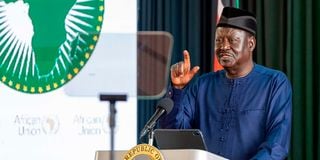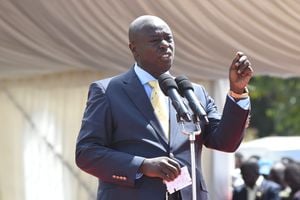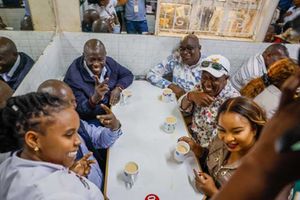Raila AU bid litmus test for Kenya’s diplomacy

Former Prime Minister Raila Odinga makes his remarks during the launch of his bid for the African Union Commission Chairmanship candidate at State House, Nairobi on August 27, 2024.
What you need to know:
- On the one hand, Raila emerges as a peacemaker and stabilising factor.
- On the other hand, questions abound around the broad-based government.
President William Ruto on Tuesday officially unveiled former Prime Minister Raila Odinga as the country’s candidate for African Union Commission (AUC) chairperson’s position.
While previous bids flopped, and consequently no Kenyan has served in that position, Raila’s candidature comes at a unique moment for Kenya.
Since June Kenya has experienced months of youth-led anti-government protests which drove the country to the brink when demonstrators invaded Parliament. In fact, the youth in many other African countries associated with the Kenyan protests on social media. Nigeria, to a lesser extent Uganda, and Bangladesh where Prime Minister Sheikh Hasina was ousted, replicated the protests.
Unrest in Kenya persisted despite concessions by President William Ruto to withdraw the Finance Bill, 2024, dissolve the Cabinet and pledge further austerity and anti-corruption reforms, until the formation of the “broad-based” Cabinet with members of Raila’s opposition party ODM in late July.
On the one hand, Raila emerges as a peacemaker and stabilising factor, which boosts his candidature. Having been Dr Ruto’s main political rival in the last General Election in 2022, the President’s open endorsement projects a positive image for Kenya, especially the resilience of its democracy.
On the other hand, questions abound around the broad-based government, which critics feel disenfranchises the youth protest movement and negatively impacts on democratic governance given human rights violations, corruption and other excesses in Kenya. Raila’s success will thus be a true measure of the President’s diplomatic astuteness and the value of Kenya’s image.
The making of the diplomat, Ruto
For nearly two years since assuming office, President Ruto has been championing the right political, economic, financial and commercial conditions for African countries and economies under the broad principle of partnership. Nicknamed the “Flying President” by local dailies, Dr Ruto has had an epic streak of 62 official and State visits to 38 countries globally, with 22 being African nations.
Besides renewing and forging new ties regionally and globally, the President sold his Pan-Africanist and development partnership ideas which have gathered him quick regional appeal and secured Kenya as a stronger African voice. The budding idea of Raila’s candidature quickly gained support across Africa as early as last year, on the coat tails of President Ruto’s strong Pan-Africanist credentials.
President Ruto’s diplomatic successes
President Ruto’s bold Pan-Africanist gamble, for African centrality in global governance structures, decision-making and negotiations, came at the time of major global geopolitical upheavals and existential threats such as climate change. In Africa, a new spate of conflict and violence was fast engulfing the region further drowning Africa’s voice at the global stage. Africa’s regional leadership lay in limbo as the leading states faced internal strife.
By the end of his first year in office, the President had successfully organised the first Africa Climate Change Summit in Nairobi, attended by 16 African heads of state, the United Nations Secretary-General, the African Union Commission chair and the European Union Foreign Minister. Bold policy proposals and strategic partnerships were reached amounting to USD 26 billion plan for green growth for Africa at the summit.
At the onset of his second year, President Ruto visited the leading world capitals in India, Japan, the United Kingdom, South Korea, Saudi Arabia, Germany, Israel, the Netherlands, France, United Arab Emirates and Switzerland, where he championed the African agenda on the various multilateral platforms and global issues.
President Ruto’s visit to Brussels where he addressed the European Parliament, the United States of America, where he was the first African leader in two decades to be accorded a State Visit and in Rome where he spoke at the G7 Summit in favour of reforming the global financial architecture, epitomised the success of President Ruto’s diplomacy.
The Eastern Africa challenge
As President Ruto launched Raila’s AUC bid in Nairobi, Kenya’s own backyard in Eastern Africa presents its toughest challenge yet! The rotational AUC chairmanship has fallen to the Eastern Africa region. While the five East Africa heads of state and government (for Burundi, Rwanda, Tanzania, Uganda and South Sudan), who graced the occasion is a positive indicator of consensus building, solidarity remains elusive in the region.
The region is fronting multiple other candidates from Mauritius, Madagascar and Djibouti, which plays into the region’s linguistic and religious (if you may, racial) divides. The challenge matters significantly to Raila’s prospects given the geopolitical undercurrents its bears.
Djibouti, Somalia and Sudan are Arab-speaking members of the League of Arab States and the Organization Islamic Cooperation (OIC) as is the entire North Africa region of 17 countries.
In fact, the majority (28) of the member states of OIC are from the African region. Eastern Africa is also faced with the Anglophone – Francophone divide where Djibouti, Madagascar and Mauritius are Francophone as other 17 countries in the Eastern, Western, Northern and Central Africa.
Besides this obvious challenge, some of the geopolitical realities which draw bridges across these divides may not favour Kenya’s candidate. For example, Ethiopia is beholden to Djibouti given that Djibouti is the only guarantor for Ethiopia to access the sea and facilitates over 90 percent of its international trade by volume. Ethiopia’s financial, security and economic ties with Djibouti’s Arab “cousins” seals its likelihood to vote for the Djiboutian candidate. Similar other situations exist elsewhere in Africa.
It is easy to entertain the argument that the multiple opponents share a constituency, hence are likely to play spoilers and occasion Raila’s win. However, should Raila fail to clinch victory in the first round and his multiple opponents unite behind one opponent in the subsequent rounds of voting, Kenya’s bid risks all mortal chances for victory.
The bottomline
As auspicious as Raila’s candidature seems, reflections on its strongest challenges is critical. For example, will Kenya manage to reclaim the image it had built before the protests and secure the Africa continental support at theAU? Has President Ruto’s Pan-Africanist thrust deepened enough across Africa to cure the Eastern Africa sub-regional headache?
Has President Ruto’s extensive diplomatic overtures blunted the effect of underlying negative geopolitical forces? Most importantly, besides Pan-Africanism, does the agenda of Raila’s candidature resonate with a young continent, whose population is 70 pe rcent youth?
Edmond Pamba is an independent geopolitical analyst and consultant: [email protected]





